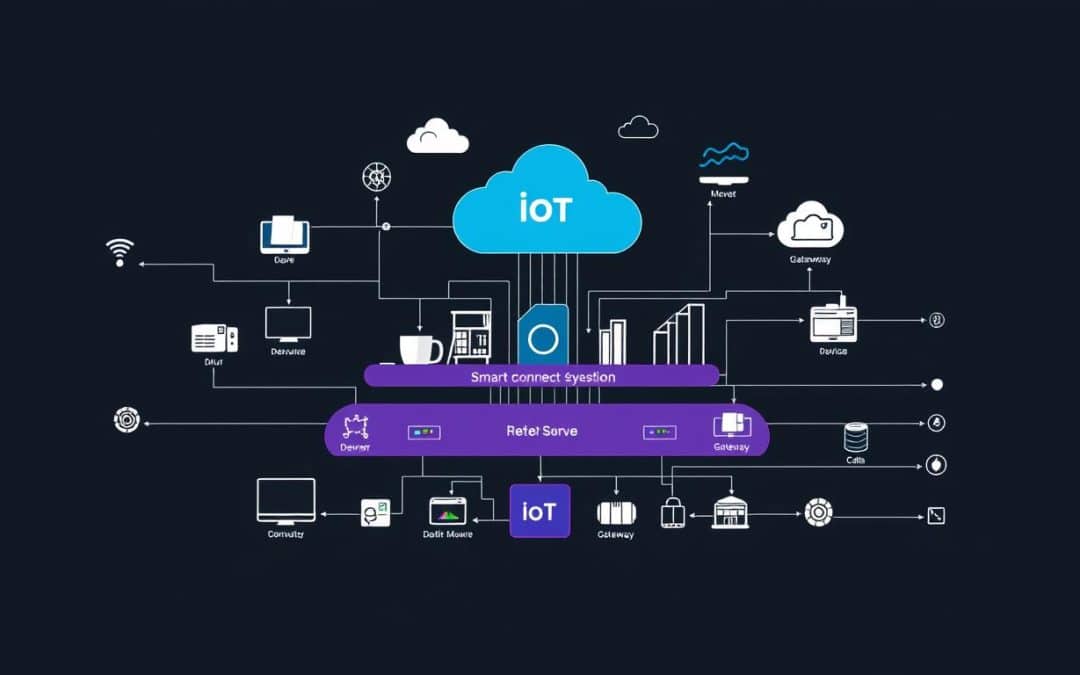The Internet of Things (IoT) is rapidly expanding, with over 75 billion connected devices projected worldwide by 2023. This massive scale underscores the critical role of IoT architecture in creating smart systems that enhance our lives, work, and public services. As technology advances, understanding the fundamentals of IoT architecture becomes essential for efficient design and seamless data flow across diverse domains.
IoT architecture is gaining prominence across industries, enabling innovative solutions and strengthening the digital economy. The future revolves around seamless connectivity through intelligent design, facilitating rapid data processing and smarter decision-making.
Key Takeaways
- Global IoT device count projected to exceed 75 billion by 2023
- Understanding IoT architecture is crucial for developing innovative solutions across sectors
- Intelligent systems design enhances the potential of smart connected systems
- Seamless connectivity is fundamental to real-time data processing
- IoT architecture significantly impacts the digital economy
Understanding IoT Architecture
IoT architecture serves as the backbone for device communication and online data sharing. It consists of three primary layers: perception, network, and application. The perception layer collects data through devices and sensors. The network layer transmits this data, while the application layer processes it for insights and actions.
Each layer plays a vital role in transforming the digital landscape. Smart cities leverage IoT for improved resource management and enhanced living conditions through real-time data analysis. In healthcare, IoT enables remote patient monitoring, improving patient care and operational efficiency.
| Layer | Description | Example Applications |
|---|---|---|
| Perception Layer | Involves hardware devices that collect data via sensors | Smart meters, wearables |
| Network Layer | Facilitates communication and data transfer between devices | Wi-Fi, cellular networks |
| Application Layer | Processes collected data and enables actionable insights | Healthcare monitoring systems, smart city management |
Key Components of IoT Architecture
Devices and Smart Devices
IoT systems rely on a wide range of devices, from smartphones to home appliances, each with a unique identifier for secure communication. The adoption of X.509 certificates enhances device-to-device security and functionality.
Embedded Sensor Networks
Embedded sensor networks capture real-time environmental data, enabling inter-device communication for automated actions. These networks are essential for the seamless operation of smart homes and factories.
Gateways and Routers
Gateways and routers direct data between devices and the cloud, ensuring secure data transmission. Cloud services like AWS, Azure, and Google Cloud Platform facilitate the integration of these components for enhanced connectivity.
Data Communication Protocols in IoT
Overview of Common Protocols
- MQTT: Ideal for networks with limited bandwidth and high latency
- CoAP: Suitable for small devices, similar to HTTP but optimized for machine-to-machine communication
- HTTP: Heavier but widely used due to compatibility with web applications
Choosing the Right Protocol for Your System
Consider factors such as data transfer efficiency, network conditions, and device compatibility when selecting a protocol for your IoT setup.
Cloud Integration in IoT Systems
Benefits of Cloud-Based Solutions
- Real-time data access for quick decision-making
- Scalability to adjust resources as needed
- Cost savings through reduced maintenance and operational expenses
Challenges with Cloud Integration
While cloud integration offers numerous benefits, it also presents challenges such as data privacy, security concerns, and integration complexity. The energy consumption of data centers, which doubles every four years and contributes up to 4% of global greenhouse emissions, raises environmental concerns.
Edge Computing: Enhancing IoT Performance
Edge computing processes data near its source, reducing latency and bandwidth requirements. This approach improves IoT device performance and responsiveness, especially crucial in applications like smart manufacturing and autonomous vehicles.
Cybersecurity in IoT Architecture
Identifying Common Security Threats
- Unauthorized device access leading to data breaches
- Malware affecting IoT system operations
- DDoS attacks overwhelming network resources
Best Practices for Securing IoT Devices
- Implement strong encryption for data transmission
- Regularly update software to address security vulnerabilities
- Educate users and developers about security best practices
Real-Time Analytics for Smart Systems
Real-time analytics enables immediate data analysis, allowing organizations to act swiftly on fresh insights. This capability is crucial for improving operational efficiency and enhancing customer experiences in IoT applications.
IoT Architecture and Intelligent Systems Design
Integrating intelligent systems design into IoT architecture enhances adaptability and scalability. This approach ensures seamless communication between devices, data, and applications, crucial for system performance and management in the evolving tech landscape.
FAQ
What is IoT architecture and why is it important?
IoT architecture forms the foundation for smart connected systems, enabling seamless data flow and connectivity. It’s crucial for operational efficiency and digital transformation across industries.
What are the key components of IoT architecture?
Essential components include devices and sensors for data collection, networks and gateways for secure data transmission, and cloud integration for data processing and storage.
How does cloud integration benefit IoT systems?
Cloud services enhance IoT system flexibility and scalability, enabling global data access and processing. However, they also raise data privacy and security considerations.
What is edge computing and why is it significant for IoT?
Edge computing processes data near its source, reducing latency and bandwidth usage. It’s crucial for applications requiring instant response, such as smart factories and autonomous vehicles.
As IoT continues to evolve, staying informed about these architectural principles and emerging trends is essential for developing robust, efficient, and secure smart connected systems.

